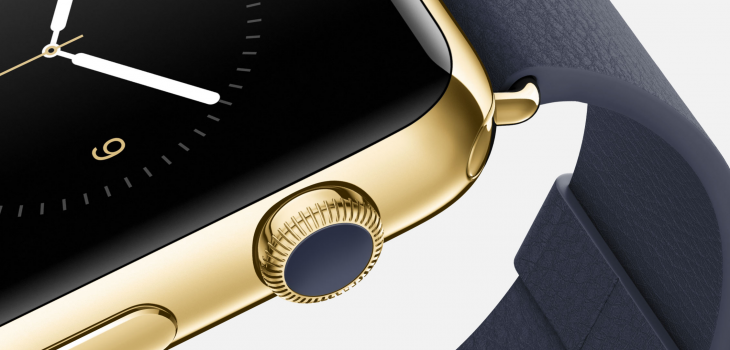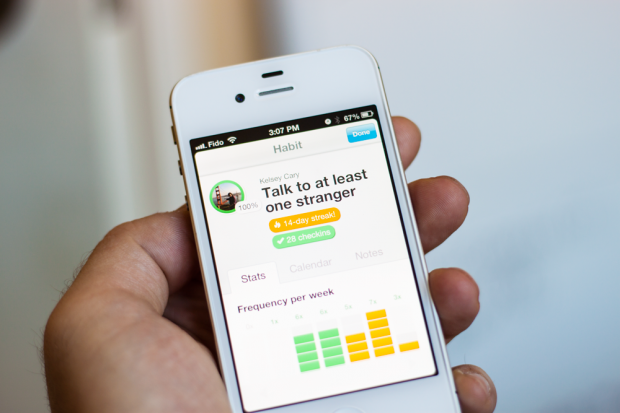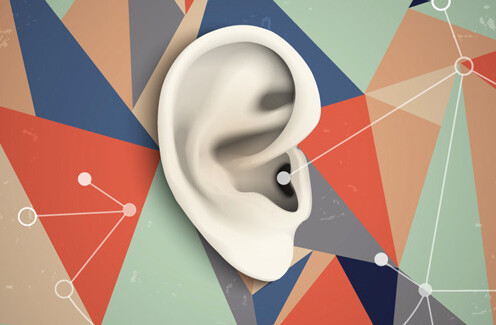
Max Ogles is the head of marketing for Mobile Coach, a startup that uses text messaging to influence employees with personalized engagement. He also has a forthcoming e-book, “Boost: Create Good Habits Using Psychology and Technology,” that you can receive for free here.
Thanks to Apple’s upcoming release of HealthKit, it won’t be long before everyone with an iPhone has access to health and quantified self tools, whether or not they want them.
Of course, hundreds of apps have offered similar features and functionality for some time, but with HealthKit as a default in iOS, a large new audience will be introduced to behavior change technology.
At the same time, hardware technology is finally reaching its potential in behavior change: GPS works better than ever, battery life finally lasts long enough to be useful and accelerometers are able to gather pretty incredible data about movement throughout the day. Because of these reasons, the Apple Watch should create a lot of momentum in the industry.
With technology up to speed and behavior change apps going mainstream, are we on the verge of seeing gym attendance reach all-time highs and the national BMI statistics drop back into a healthy range?
I doubt it. Technology certainly seems like the ideal resource for creating habits and changing behaviors. Our cell phones are ubiquitous, just like our habits, so it’s only natural that we should use one to affect the other.
But for a variety of reasons, most wearables, quantified self tools, and behavior change apps have a short shelf life. Just as one example, over 50 percent of people using wearables have given up on them after six months.
There are a handful of very specific challenges that the industry faces, all of which I’ve encountered working with product teams to build behavior change Web platforms, apps and even a program based on SMS. Each product was aimed at helping people change their behavior and each product faced similar challenges.
I’ve also used enough apps and tools myself to recognize that other companies struggle with the same issues. Can we fix them? I’m not sure. But if we take a look at some of the more prevalent challenges maybe we can all find solutions together.
Let’s take a look at the top five challenges facing wearables, quantified self, and behavior change technology today.
1. Apathy
At first glance, there appears to be a huge market for behavior change. If you take just weight loss, for example, more than 66 percent of Americans are overweight.
But you can’t just force people to be healthy – they have to be motivated to change. A Gallup poll from last year shows that 51 percent of Americans want to lose weight, but only 25 percent of Americans are actively trying to lose weight.
That’s still a significant number, which is why the value of the weight loss market is over $60 Billion, but less than half of the people who want to lose weight are actually trying to do it.
For behavior change technology, the ideal customers are people that are actively looking to change their behavior because it’s so difficult to create motivation otherwise.
That means regardless of how effective your technology is, it will never reach a large number of people that need it, simply because they aren’t ready to change
Behavior change is extremely difficult, even for someone who is motivated; for someone who isn’t motivated, it’s impossible.
2. Simplicity vs. Complexity
Every company working to change behavior struggles with the balance between simplicity and complexity. Simplicity is the hallmark of many of the most successful apps – think Snapchat and Instagram – and it’s essential to an engaging user experience in behavior change as well.
The difficulty lies in the complexity of the psychology of behavior change. You can’t just shove complex psychology (such as cognitive-behavioral therapy) into an app and expect an incredible user experience.
If you come from an academic background, you’re likely to build an app that is psychologically sound and has dozens of features, but suffers from poor UI and confuses users. Alternatively, if you come from a tech background, you’re likely to build a beautiful intuitive app that users enjoy, but maybe doesn’t fully leverage the psychology of behavior change.
You can observe this difficult dynamic in the way that the Lift app has developed. It began as simple daily tracking, which was an enjoyable experience but best served for simple goals, like flossing, rather than serious behavior change, such as quitting smoking.
But based on what I’ve read from CEO Tony Stubblebine’s product notes, the team also has a sound foundation in psychology. They’ve slowly and deliberately moved toward more advanced types of change by including live coaching, step by step programs, etc. and it will be interesting to see how they continue to balance simplicity of design with the complexity of behavior change within the app.
3. Personalization vs. Scale
Part of the allure of technology in behavior change is that we assume it can scale. Many behavior tech companies are startups and, as Paul Graham wrote, “A startup is a company designed to grow fast.”
But when you look at the way psychology is generally applied in a clinical setting, the best results come from one-on-one interactions: a trained expert working with an individual. In this case of behavior change startups, personalization competes with scalability.
It’s easy to find companies that have taken both approaches. As one example, Sessions (which was acquired by MyFitnessPal) recognized the value of individual interactions in tackling weight loss. As a result, its services had a higher price point and weren’t as scalable as other weight loss options, such as apps.
This may very well be the reason that it made sense for MyFitnessPal to acquire Sessions. With the acquisition, MyFitnessPal may be able to incorporate a more deliberate, personalized approach to behavior change that complements the widespread scale it has achieved with its app.
4. Relapse
Although relapse occurs frequently as people struggle to change bad habits, few companies attempt to address relapse within their products.
When addicts receive psychological counseling to overcome drug or alcohol addictions, the process of anticipating and preventing relapse is integral to lasting behavior change. However, this important step is almost always overlooked in technologies that try to help people change behavior.
So why is it so crucial to address relapse? First, because it nearly always occurs. It’s a constant in the behavior change process and achieving lasting change requires the ability to recognize when, where and why relapses are likely to occur.
Secondly, relapse in the behavior change process coincides with abandonment of the app or technology that is helping with the change. If I’m tracking my calories in a weight loss app, for example, but then I give in to temptation and eat a whole carton of ice cream, I’m likely to give up on my goal AND the app.
But if the app helps me to anticipate occasional missteps, and coaches me through how I will react when they occur, I’ll not only stick to my plan but continue to love the app even more.
5. Integration in real life
While it’s true that we nearly always have our phones with us, much of what we use them for doesn’t intersect with what we’re actually physically doing.
Most apps or tools that actually do integrate with real-life activities are used to track data: how far did I run, how well did I sleep, how many calories did I burn, etc. Tracking tools can be excellent but they generally cater to a specific group of people, the ones who are actually active. An inactive user faces a significant challenge of moving to action.
There exists a natural barrier between doing something on your phone (reading or clicking) and taking action in real life. If an app is designed to motivate you to exercise, putting down your phone and going to exercise can be a massive hurdle, especially since technology makes other distractions, like Candy Crush, so accessible.
For technology to have an effect on behavior change, it needs deeper engagement with the actual physical activity. Gamification might be one way to achieve this, but there may also need to be changes in user interface or hardware to really have the technology become part of the experience.
This is also an area where the Apple Watch could have an impact. Many wearables lose their appeal over time because people get sick of tracking health data.
However, the Apple Watch promises widespread appeal beyond just fitness. The broad appeal of the watch will likely lead consumers to continue using it much longer than if it offered just the fitness functionality.
Technology will continue to improve and hopefully some of these major challenges will be mitigated. But for now, these are challenges that all companies and products will face in the area of behavior change technology.
As the momentum continues (from HealthKit, Apple Watch, Android Wear and other major advances) and hundreds of smart people collaborate to solve the problem, technology will begin to have a major impact on the individual consumer’s ability change behavior.
Read next: Can online apps change real life behavior?
Get the TNW newsletter
Get the most important tech news in your inbox each week.









